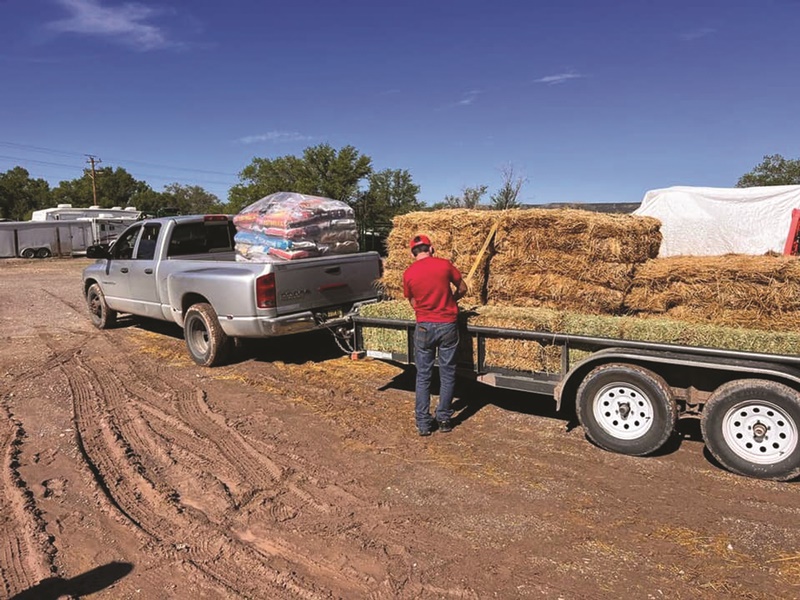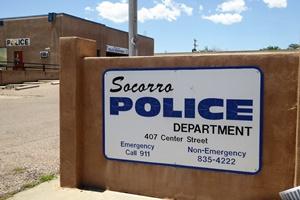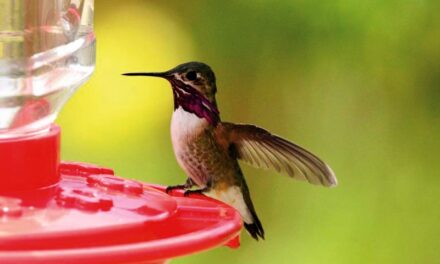
A worker loads up hay and other feed at Williams Ranch Supply in Quemado last Thursday for delivery to ranchers struggling with the loss of grazing land in the Black Fire.
Photo courtesy Jimbo Williams
The Black Fire has consumed over 325,000 acres of timber and grassland in Sierra County, but as of Monday due to successful firefighting efforts, the fire is 70 percent contained, and resources are either demobilizing to return to their home units, or reassigning to assist other wildfires across the country.
Throughout the fire – which started May 13 – cattle ranchers have had to relocate their herds from either allotments or private land, which meant the animals could not graze normally. Besides the smoke and the fire itself, much of the grassland the cattle depended on had burned.
This is when Jimbo Williams, along with the New Mexico Cattlegrowers Association, stepped in with feed and hay.
“The ranchers down there, a lot of them are displaced,” said Williams, who runs Williams Ranch Supply in Quemado. “They had to get their cattle out of there so they wouldn’t burn. And of course, once they got them in a pen, there’s nothing for them to eat, so that’s why they were needing feed.”
He said that “even if they’re going back to their normal pasture land, everything’s been burned up and they’ll have to wait for the grass to grow back for the cattle to have anything to eat.”
Loren Patterson, president of the New Mexico Cattlegrowers Association, said the organization has created a special fund for emergencies such as this.
“We established what we call our Producer Relief Fund several years ago after that winter storm, Goliath, in 2016,” Patterson said. “We had some producers that we had airlifted hay to after that storm. We established the fund then, and there was a great response of donations from organizations and different allied industries that are members of our association, such as Farm Credit of New Mexico.”
He said although government programs will step in with relief in times of emergency, often that help is not quick enough.
“So what we try to do is tend to those immediate needs during a natural disaster and bridge that gap between what Farm Service Agency or some of the government agencies do,” Patterson said. “But that may be up to 60 days coming before they get that action from the government level, so we try to fill the immediate most pressing needs.”
Like hay and feed.
“In the case of the Black Fire, we’ve been real fortunate. We’ve had a lot of great donations that we helped pay for the trucking or feed,” he said. “We just try to help get it there, working with the New Mexico Department of Agriculture, New Mexico Livestock Board, or the Extension Service to get those things where they’re needed.”
Williams Ranch Supply in Quemado was one of the recipients of the Cattlegrowers Relief Fund.
“We had a whole bunch of people donate and New Mexico Cattlegrowers is one of the biggest donors. They sent us a check for $5,000,” Williams said. “Then we had another $5,000 worth of donations or like-product donated, and then we donated probably about $2,000 out of our own pocket of product. Cattle cubes and horse feed, some chicken feed, dog food, and cat food. A whole slew of stuff.”
Williams cited Jaedean Bugayong of Quemado as instrumental in the effort, locally.
“She came to us to say, ‘Can you help us with a little bit of feed?’ so we just threw it out there in the universe. The support from the community was just overwhelmingly awesome,” Williams said. “Around 20-30 people in the Quemado area have been part of the donation effort. We ourselves donated a truckload of hay to the Las Vegas area, prior to this fire.”
Patterson said the heads of cattle that had to be moved “is in the thousands. It’s hard to say because that’s such a rugged area. Some people just moved over to their neighbor’s ranch for a few days.”
He said the Cattlegrowers Association works closely with the New Mexico Livestock Board.
“We sent Jimbo’s Williams Ranch Supplies $5,000, but before that sent three separate loads of hay down there through the Extension Service and Livestock Board.
“The Livestock Board knows which ranchers were most seriously affected. What’s burned on each ranch,” Patterson said. “Because they’re the ones who have to inspect those cattle coming or going, or when they’ve moved. That’s how we know how to assess those needs.”



















